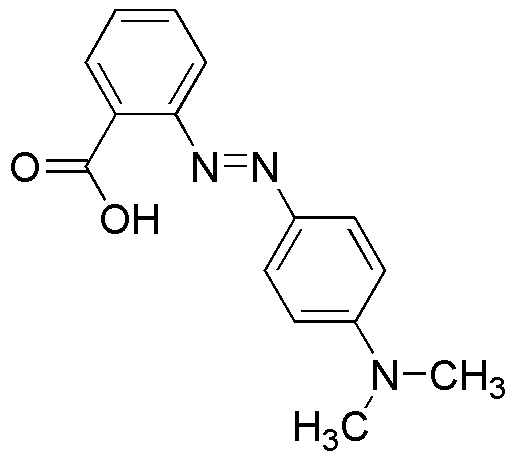Methyl Red free acid is widely utilized in research focused on:
- pH Indicator: Commonly used in titrations, it changes color at a pH range of 4.4 to 6.2, making it ideal for determining the acidity of solutions in laboratories.
- Biological Research: Employed as a staining agent in microbiology to differentiate between various types of bacteria based on their metabolic activity.
- Textile Industry: Utilized as a dye for fabrics, providing vibrant colors while being less toxic compared to some other synthetic dyes, thus promoting safer manufacturing processes.
- Food Industry: Used as a food coloring agent in certain products, offering a visually appealing option while adhering to regulatory standards for safety.
- Environmental Testing: Applied in assessing the acidity of soil and water samples, helping researchers monitor environmental health and compliance with regulations.
General Information
Properties
Safety and Regulations
Applications
Methyl Red free acid is widely utilized in research focused on:
- pH Indicator: Commonly used in titrations, it changes color at a pH range of 4.4 to 6.2, making it ideal for determining the acidity of solutions in laboratories.
- Biological Research: Employed as a staining agent in microbiology to differentiate between various types of bacteria based on their metabolic activity.
- Textile Industry: Utilized as a dye for fabrics, providing vibrant colors while being less toxic compared to some other synthetic dyes, thus promoting safer manufacturing processes.
- Food Industry: Used as a food coloring agent in certain products, offering a visually appealing option while adhering to regulatory standards for safety.
- Environmental Testing: Applied in assessing the acidity of soil and water samples, helping researchers monitor environmental health and compliance with regulations.
Documents
Safety Data Sheets (SDS)
The SDS provides comprehensive safety information on handling, storage, and disposal of the product.
Product Specification (PS)
The PS provides a comprehensive breakdown of the product’s properties, including chemical composition, physical state, purity, and storage requirements. It also details acceptable quality ranges and the product's intended applications.
Certificates of Analysis (COA)
Search for Certificates of Analysis (COA) by entering the products Lot Number. Lot and Batch Numbers can be found on a product’s label following the words ‘Lot’ or ‘Batch’.
*Catalog Number
*Lot Number
Certificates Of Origin (COO)
This COO confirms the country where the product was manufactured, and also details the materials and components used in it and whether it is derived from natural, synthetic, or other specific sources. This certificate may be required for customs, trade, and regulatory compliance.
*Catalog Number
*Lot Number
Safety Data Sheets (SDS)
The SDS provides comprehensive safety information on handling, storage, and disposal of the product.
DownloadProduct Specification (PS)
The PS provides a comprehensive breakdown of the product’s properties, including chemical composition, physical state, purity, and storage requirements. It also details acceptable quality ranges and the product's intended applications.
DownloadCertificates of Analysis (COA)
Search for Certificates of Analysis (COA) by entering the products Lot Number. Lot and Batch Numbers can be found on a product’s label following the words ‘Lot’ or ‘Batch’.
*Catalog Number
*Lot Number
Certificates Of Origin (COO)
This COO confirms the country where the product was manufactured, and also details the materials and components used in it and whether it is derived from natural, synthetic, or other specific sources. This certificate may be required for customs, trade, and regulatory compliance.


